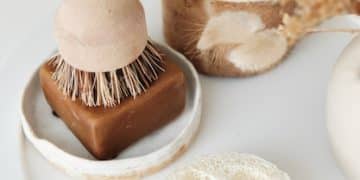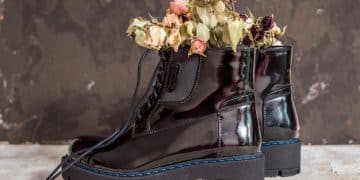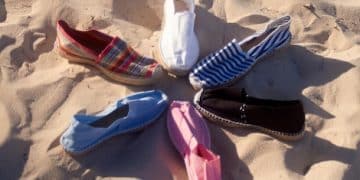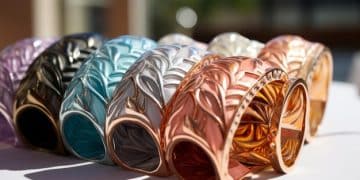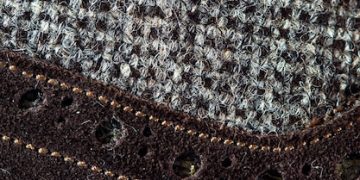Designer Shoe Care 101: Extend Lifespan by Up to 5 Years
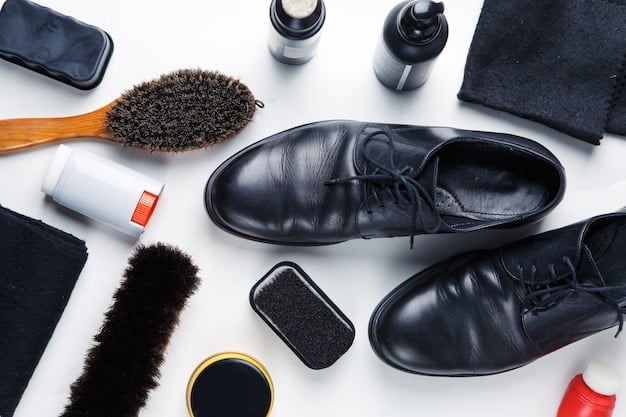
Achieving up to five years of extended life for designer shoes involves adopting a consistent regimen of cleaning, conditioning, proper storage, repair, and mindful wear, safeguarding your luxury investment against premature deterioration.
Investing in designer shoes represents more than just a purchase; it’s an acquisition of craftsmanship, style, and often, heritage. But like any valuable asset, these exquisite pieces demand diligent care. In this comprehensive guide, we delve into Designer Shoe Care 101: Extend the Life of Your Investment by Up to 5 Years, offering actionable insights to preserve their beauty and integrity for years, ensuring your prized footwear remains a staple in your wardrobe.
Understanding Your Investment: Beyond the Price Tag
Investing in designer footwear goes far beyond mere aesthetics; it embodies an appreciation for meticulous craftsmanship, premium materials, and often, a storied brand history. When you acquire a pair of high-end shoes, you’re not just buying an accessory, but a piece of wearable art, designed with a blend of tradition and innovation. This level of intrinsic value demands commensurate care to ensure its longevity. The materials used, be it exotic leathers, delicate silks, or intricate embellishments, are chosen for their beauty and quality, but also require specific handling to maintain their pristine condition. Without proper care, even the most robust materials can succumb to wear and tear, diminishing their appearance and structural integrity.
The Craftsmanship and Materials Behind Designer Footwear
Designer shoes are often constructed using methods that prioritize durability and comfort, such as Goodyear welting or Blake stitching, which allow for easier resoling and repair. This contrasts sharply with mass-produced shoes where components are often glued, making repairs difficult or impossible. Understanding these construction methods can inform your care routine. For instance, a Goodyear welted shoe benefits from regular sole conditioning to prevent cracking, while a delicate satin pump requires protection against water and abrasions.
- Premium Leathers: From supple calfskin to exotic python, each leather type has unique porosity and texture, dictating specific cleaning agents and conditioning techniques.
- Delicate Fabrics: Silks, satins, and suedes demand gentle, dry cleaning methods and protection from moisture and stains.
- Hand-Embellishments: Beads, crystals, and delicate embroidery on shoes require careful handling to prevent snagging or breakage, advocating for specialized storage.
Recognizing the True Value of Longevity
The value of a designer shoe can appreciate over time, particularly for limited editions or iconic styles. Preserving their original condition is paramount, not only for personal enjoyment but also for potential resale value. A well-maintained shoe retains its shape, color, and structural integrity, characteristics highly sought after in the pre-owned luxury market. Conversely, neglected shoes rapidly lose their appeal and financial worth, making diligent care a protective measure for your investment.
Neglecting regular maintenance accelerates the deterioration of valuable materials. Cracks in leather, fading colors, and compromised structural components turn an exquisite item into a worn-out relic much faster than necessary. For example, ignoring proper conditioning for leather can lead to irreversible damage, manifesting as deep creases and a brittle texture. Similarly, failure to protect delicate outer materials can result in permanent staining or damage that professional restorers might struggle to remedy. Proactive care ensures that the shoe’s aesthetic and functional life are maximized, allowing you to enjoy your purchase for many years, rather than just a few seasons. This diligent approach validates the initial investment by extending its utility and beauty.
Foundation of Care: Daily Habits and Immediate Actions
The cornerstone of extending the life of your designer shoes lies in establishing consistent daily habits and reacting promptly to wear and tear. It’s often the small, consistent efforts that prevent minor issues from spiraling into significant damage. Just as you wouldn’t leave a luxury car unwashed or unserviced, your designer footwear requires immediate attention to maintain its pristine condition. This approach safeguards the materials and construction from premature degradation, directly contributing to extending their lifespan significantly.
Post-Wear Rituals: Cleaning and Airing
As soon as you remove your shoes, a quick inspection can make a substantial difference. Dirt, dust, and grime can accumulate on the surface and within the crevices, becoming harder to remove over time. Moreover, foot perspiration can be detrimental to internal linings and insoles if left to linger. A simple wipe-down and proper airing can prevent many common issues, preserving both the shoe’s exterior and interior environment. This ritual helps in preventing accumulation of problematic elements.
- Gentle Wiping: Use a soft, lint-free cloth or a dedicated shoe brush to remove superficial dirt and dust. For leather, a slightly damp cloth followed by a dry one works wonders.
- Airing Out: Never store shoes in a confined space immediately after wearing them. Allow them to air out for at least 24 hours in a well-ventilated area to dissipate moisture and odors.
- Addressing Stains Promptly: For spills, blot immediately with a clean cloth. Different materials require different stain removal techniques; researching the appropriate method for the specific material is crucial.
The Role of Shoe Trees and Stuffing
Maintaining the original shape of your shoes is critical to preventing creases and structural collapse. Shoe trees, particularly those made of cedar, are indispensable for this purpose. Cedar wood absorbs moisture and deodorizes, further aiding in the post-wear drying process. For shoes that don’t accommodate shoe trees, such as certain boots or delicate fabrics, stuffing them with acid-free tissue paper can serve a similar purpose, providing internal support without causing damage.
Neglecting to use shoe trees can lead to permanent creasing and deformation of the shoe’s upper, particularly in leather. This not only detracts from the shoe’s aesthetic appeal but can also compromise its structural integrity, leading to premature cracking. The consistent pressure exerted by shoe trees helps to smooth out minor wrinkles that accumulate during wear, ensuring the shoe maintains its intended silhouette over time. This simple step is fundamental in preserving the shoe’s original form.
Deep Cleaning & Conditioning: The Seasonal Overhaul
While daily maintenance prevents immediate damage, periodic deep cleaning and conditioning are essential for long-term preservation of designer footwear. This seasonal overhaul addresses deeper grime, replenishes natural oils in leather, and provides comprehensive protection against environmental elements. The frequency of these deep treatments depends on how often the shoes are worn and the conditions they are exposed to, but a general rule of thumb is every few months or before and after significant periods of wear. It’s a proactive step in extending the shoe’s life.
Leather Care: Nourish and Protect
Leather, being a natural material, requires regular nourishment to prevent it from drying out, cracking, and losing its suppleness. Conditioning products replenish the natural oils that are lost through wear and exposure to elements. Following a thorough cleaning, apply a high-quality leather conditioner evenly, allowing it to penetrate before buffing to a gentle sheen. This process not only preserves the leather’s texture but also its vibrant color.
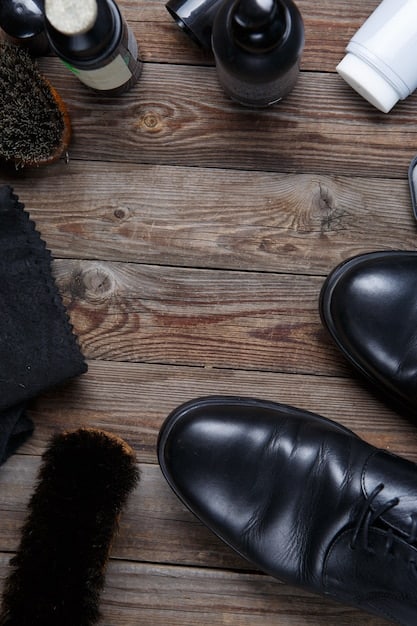
- Cleaning: Use a specialized leather cleaner to remove accumulated dirt and old polish. Always test on an inconspicuous area first.
- Conditioning: Apply a small amount of leather conditioner with a soft cloth, massaging it into the leather in circular motions.
- Polishing: Once conditioned, a specific shoe polish can restore color and add a protective layer. For patent leather, a damp cloth and specialized cleaner are preferred.
Suede & Nubuck: Gentle and Specialized Care
Suede and nubuck have a delicate napped finish that requires a different approach than smooth leather. Water can stain them, and harsh brushes can damage the nap. These materials benefit most from dry cleaning methods and specialized tools. A dedicated suede brush helps to lift dirt and restore the nap, while a suede eraser can tackle stubborn marks. Applying a protective spray after cleaning is crucial for repelling water and stains, offering an invisible shield.
Frequent exposure to moisture or abrasive surfaces can flatten the nap and make suede appear worn, even when the underlying material is intact. Regular light brushing helps to maintain its soft, velvety texture and prevents dirt from bonding deep within the fibers. For serious stains, professional cleaning is often the safest bet. It’s always better to address issues before they become permanent, preserving the unique character of these materials.
Fabric & Embellishment Care: Delicate Touch
Shoes made from satin, silk, canvas, or those with intricate beadwork and embroidery demand the gentlest care. These materials are highly susceptible to water damage, staining, and snagging. Spot cleaning with a very mild solution and a soft cloth is usually the safest bet, avoiding excessive moisture. For heavily embellished shoes, it might be safer to consult a professional shoe cleaner who specializes in delicate materials to avoid accidental damage to the intricate details.
The structural integrity of embellishments can be compromised by improper cleaning. Harsh chemicals or excessive scrubbing can loosen threads, detach beads, or dull the shine of crystals. Therefore, minimal intervention is often the best approach. When storing these items, ensure they are not pressed against other objects that could cause snagging or crushing of the delicate elements, as this can lead to permanent alterations to their appearance and structure.
Strategic Storage: Protecting Your Investment from the Elements
Proper storage is a crucial, yet often overlooked, aspect of designer shoe care. It’s not enough to simply clean and condition your shoes; how and where you store them can significantly impact their longevity. Exposure to environmental factors like humidity, extreme temperatures, and direct sunlight can cause irreparable damage to delicate materials, leading to fading, cracking, and compromise of structural integrity. Strategic storage safeguards your investment, preserving its quality for years.
Controlling Environmental Factors
The ideal storage environment for designer shoes is cool, dry, and well-ventilated, with stable temperatures and moderate humidity levels. Fluctuations in temperature and humidity can cause materials to expand and contract, leading to cracking in leather or mold growth on fabrics. Direct sunlight is particularly harmful, as it can cause colors to fade and materials to become brittle. A dark, temperature-controlled closet or wardrobe is generally the best place for long-term storage.
- Humidity Control: Consider using silica gel packets or a dehumidifier in storage areas prone to moisture to prevent mold and mildew.
- Temperature Stability: Avoid storing shoes in attics or basements where temperatures can fluctuate wildly.
- Light Protection: Always store shoes away from direct sunlight or harsh artificial light sources to prevent fading.
Individual Protection: Dust Bags and Boxes
Each pair of designer shoes should ideally be stored in its original dust bag and, if available, its original box. Dust bags, typically made of flannel or soft cotton, protect the shoes from dust accumulation and minor abrasions while allowing them to breathe. The original boxes provide an additional layer of protection against light, dust, and physical damage, and they help maintain the shoe’s shape. If original boxes are unavailable, acid-free shoe boxes are a good alternative.
These protective measures are not merely aesthetic; they play a practical role in deterring damage. Dust can settle into the intricate textures of materials, leading to microscopic abrasions over time. Furthermore, dust can attract moisture, contributing to mildew growth. The original box, designed specifically for the shoe’s dimensions, offers crucial structural support, preventing deformation that might occur if shoes are simply left on a shelf or piled in a closet, particularly for delicate heels or pointed toes.
Professional Restoration and Timely Repairs
Even with the most diligent at-home care, designer shoes will eventually require professional attention. Timely repairs and strategic restoration can significantly extend their lifespan, often preventing minor issues from escalating into irreversible damage. Knowing when to seek professional help and choosing the right expert are crucial steps in preserving your valuable footwear. A skilled cobbler or restorer can perform miracles, bringing seemingly ruined shoes back to life.
When to Seek Professional Help
There are certain signs that indicate it’s time to consult a professional cobbler or shoe restorer. These include worn-down heels or soles, compromised stitching, deep scuffs or tears in leather, and persistent stains that home remedies cannot address. Professional intervention is particularly important for structural issues, as these can quickly lead to irreparable damage if neglected. A good cobbler can often replace an entire sole or heel, or meticulously repair a torn leather upper.
For instance, ignoring a worn heel can lead to uneven weight distribution, which not only causes discomfort but also puts undue stress on the shoe’s structure, potentially causing the upper to detach from the sole. Similarly, a small tear in the leather, if left unrepaired, can quickly expand, making the repair more complex and costly. Early intervention saves money in the long run by preventing irreversible damage and preserving the shoe’s original integrity.
Choosing the Right Cobbler or Restorer
Selecting a reputable cobbler or shoe restorer is paramount. Not all professionals have the expertise or specialized tools required for designer footwear. Look for someone with experience handling high-end brands and delicate materials. Ask for recommendations, read reviews, and don’t hesitate to inquire about their methods and experience with specific shoe types or materials. A good professional will often offer a consultation and transparent pricing.
- Specialization: Seek out professionals who specifically mention expertise in luxury footwear.
- Materials Knowledge: Ensure they understand the nuances of working with different leathers, fabrics, and embellishments.
- Reputation: Check online reviews, ask for testimonials, or seek word-of-mouth recommendations from other luxury shoe owners.
The Art of Restoration: Beyond Simple Repair
Professional restoration goes beyond simple repairs; it involves restoring the shoe to its original glory. This can include re-dyeing faded leather, reinforcing weakened structures, or even recreating missing embellishments. These services can add years, even decades, to the life of a cherished pair of shoes, making them a worthwhile investment. Sometimes, a shoe you thought was beyond saving can be completely revitalized through expert care.
The skills involved in high-end shoe restoration are akin to those of an artisan. They understand how different materials react to treatments and have the patience to perform intricate tasks such as matching original leather dyes or precisely restitching delicate seams. This meticulous attention to detail ensures that the restored shoe retains its authenticity and continues to embody the quality and prestige of its original design.
Mindful Wearing: Extending Life Through Smart Choices
The way you wear your designer shoes plays as significant a role in their longevity as cleaning and storage. Mindful wearing involves making conscious choices about when and where to wear your shoes, protecting them from unnecessary stress and exposure to damaging elements. It’s about respecting your investment by aligning its use with its delicate nature. This approach significantly reduces wear and tear, allowing your shoes to stay in pristine condition for a much longer period.
Rotation and Rest
One of the simplest yet most effective strategies for extending shoe life is regular rotation. Avoid wearing the same pair of designer shoes every day. Allowing shoes to rest for at least 24-48 hours between wears gives them time to air out, dry completely from internal moisture, and for the materials to relax and regain their original shape. Constant wear without rest can accelerate deterioration, especially for leather.
Wearing the same pair repeatedly without allowing them to fully dry can foster bacterial growth, leading to unpleasant odors and deteriorating internal linings. Furthermore, continuous compression on the soles and uppers without a period of recovery can lead to permanent creasing and structural fatigue. Rotation ensures each pair gets the necessary rest, distributing the stress of wear across multiple pairs and extending the overall life of your collection.
Weather and Terrain Considerations
Designer shoes, especially those made from delicate materials like suede, satin, or fine leather, are not designed for harsh weather conditions or rough terrain. Rain, snow, mud, and abrasive surfaces can cause immediate and irreversible damage. It is wise to have a selection of more robust, purpose-built footwear for inclement weather or outdoor activities. If caught in unexpected rain, dry your shoes properly immediately upon returning home.
- Avoid Moisture: Do not wear delicate shoes in rain or snow without proper waterproofing treatment. Even then, heavy precipitation should be avoided.
- Choose Surfaces Wisely: Steer clear of gravel, uneven paving, or grassy areas that can scuff materials or get stuck in delicate soles.
- Protective Soles: For leather-soled shoes, consider having a thin rubber protective sole added by a cobbler to extend their life and provide better grip.
The Importance of a Shoe Horn
Using a shoe horn is a small but critical habit that protects the heel counter of your shoes. Forcing your foot into a shoe without a shoe horn can crush the heel, weakening its structure and leading to premature wear and tear on the lining. A shoe horn guides your foot smoothly into the shoe, preserving its integrity and making it easier to put on without causing damage. This simple tool safeguards a vulnerable part of the shoe.
Ignoring the use of a shoe horn can lead to irreversible damage to the heel collar and counter, causing them to collapse or fray prematurely. This not only makes the shoe uncomfortable to wear but also detracts significantly from its aesthetic appeal. Over time, repeated strain on this area can compromise the shoe’s overall fit and stability. A simple shoe horn effectively prevents this, maintaining the shoe’s original form factor.
Advanced Techniques & Specialized Treatments
Beyond standard cleaning and conditioning, there are advanced techniques and specialized treatments that can further enhance the protection and longevity of designer shoes. These often involve specific products or professional services designed to address particular material needs or provide an extra layer of defense against challenging conditions. Incorporating these into your routine can be the difference between a simply cared-for shoe and one that lasts for decades.
Waterproofing and Stain Repellents
While avoiding inclement weather is ideal, it’s not always practical. High-quality waterproofing and stain repellent sprays can provide an invisible barrier against moisture and spills for various materials, including leather, suede, and fabric. These treatments should be applied regularly, following the product’s instructions, and re-applied after deep cleaning or exposure to harsh conditions. They create a protective layer, minimizing the risk of permanent damage.
Many people falsely assume that one application is sufficient for the lifetime of the shoe, but these treatments wear off with use and environmental exposure. Regular reapplication, especially before and after the rainy season, ensures continuous protection. When water or stains are repelled effectively, it mitigates the need for aggressive cleaning, which can be harsh on delicate materials. This proactive approach saves time and reduces potential material damage.
Leather Glazing and Edge Dressing
For smooth leather shoes, glazing and edge dressing are specialized treatments that restore shine and protect vulnerable areas. Glazing, often performed by professionals, can bring back a deep luster, while edge dressing meticulously re-colors and seals the edges of the soles and uppers, preventing fraying and moisture penetration. These details often suffer significant wear and tear, and addressing them prolongs the shoe’s overall neatness and durability.
The edges of leather shoes are particularly susceptible to abrasion and scuffing, which can degrade the material and allow moisture ingress. Edge dressing re-seals these vulnerable areas, preventing the leather from fraying and maintaining a polished appearance. This detailed attention to often-overlooked areas significantly contributes to the overall longevity and aesthetic appeal of the footwear, ensuring every part of the shoe is protected and maintained.
Addressing Odors and Interior Hygiene
The interior of a shoe can be a breeding ground for bacteria and odors, especially with repeated wear. Regular airing, coupled with specialized odor absorbers or shoe fresheners, can maintain internal hygiene. For persistent issues, professional interior cleaning or sanitization might be necessary. Keeping the interior fresh not only prevents unpleasant smells but also protects linings and insoles from premature deterioration, contributing to comfort and longevity.
Good internal hygiene also prevents degradation of the shoe’s internal components. Left unchecked, moisture and bacteria can cause insoles to deteriorate, leading to discomfort and the need for costly replacements. Moreover, foul odors can often permeate the entire shoe, making it unpleasant to wear, regardless of the exterior condition. Proactive internal care extends the lifespan of the entire shoe, ensuring comfort and aesthetic appeal.
| Key Point | Brief Description |
|---|---|
| ✨ Daily Rituals | Clean and air shoes after each wear; use shoe trees to maintain shape. |
| 🧴 Deep Cleaning | Periodically clean, condition, and polish leather; use specialized care for suede and fabrics. |
| 🏡 Smart Storage | Store in cool, dry, dark places using dust bags and original boxes to protect from elements. |
| 🛠️ Professional Help | Seek professional cobblers for timely repairs and extensive restoration, like sole replacement. |
Frequently Asked Questions
▼
Daily light cleaning (wiping down) after each wear is recommended. Deep cleaning and conditioning should be done every few months, or more frequently based on wear and material type, to prevent buildup and nourish materials.
▼
It’s best to use high-quality, specialized shoe polish or creams formulated for luxury leathers. Generic polishes may contain harmful chemicals that can damage premium materials. Always match the polish color to your shoe or use a neutral shade.
▼
Yes, shoe trees are highly recommended. They help maintain the shoe’s original shape, prevent creasing, and absorb moisture, which can significantly extend the life and appearance of your designer footwear, especially for leather.
▼
For suede, apply a high-quality, specialized waterproofing spray thoroughly before the first wear and reapply periodically. It creates a protective barrier against moisture and stains. Avoid wearing suede shoes in heavy rain or snow whenever possible.
▼
Consult a professional cobbler for significant issues like worn-down soles or heels, deep scuffs, major tears, or persistent stains that home methods can’t fix. Timely professional repairs prevent minor problems from becoming irreparable damage, protecting your investment.
Conclusion
The journey of extending the lifespan of your designer shoes by up to five years, or even more, is a testament to mindful investment and disciplined care. By embracing the principles of diligent cleaning, strategic conditioning, proper storage, timely repairs, and thoughtful wear, you aren’t just preserving a material possession; you’re safeguarding a piece of artistry and personal style. Each effort, from a simple wipe-down after an evening out to a professional restoration, contributes to maintaining their beauty, comfort, and enduring value. This comprehensive approach ensures that your cherished footwear remains a vibrant part of your wardrobe, ready to elevate every step for years to come.
